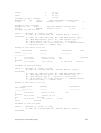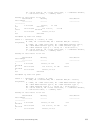
The show VRF commands displays the following output:
Dell# show ip route vrf VRF-Blue
C 122.2.2.0/24 Direct, Te 1/22 0/0 22:39:61
O 22.2.2.2/32 via 122.2.2.2 110/0
00:00:11
O 44.4.4.4/32 via vrf-red:144.4.4.4 0/0 00:32:36
<< only OSPF and BGP leaked from VRF-red
Important Points to Remember
• Only Active routes are eligible for leaking. For example, if VRF-A has two routes from BGP and OSPF,
in which the BGP route is not active. In this scenario, the OSPF route takes precedence over BGP.
Even though the Target VRF-B has specified filtering options to match BGP, the BGP route is not
leaked as that route is not active in the Source VRF.
• The export-target and import-target support only the match protocol and match prefix-list options.
Other options that are configured in the route-maps are ignored.
• You can expose a unique set of routes from the Source VRF for Leaking to other VRFs. For example, in
VRF-red there is no option for exporting one set of routes (for example, OSPF) to VRF- blue and
another set of routes (for example, BGP routes) to some other VRF. Similarly, when two VRFs leak or
export routes, there is no option to discretely filter leaked routes from each source VRF. Meaning, you
cannot import one set of routes from VRF-red and another set of routes from VRF-blue.
Virtual Routing and Forwarding (VRF)
941


















